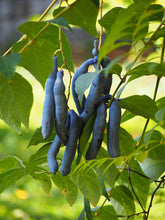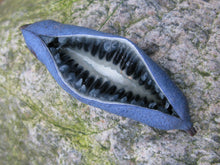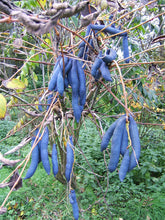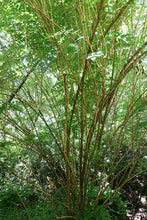Mao Er Shi Shu
Regular price
$5.00
Sale
Decaisnea fargesii
Origin: China & Burma (via Poland)
Improvement status: Cultivated wild material
Seeds per packet: ~10
BOTANICAL SAMPLE - NOT GERMINATION TESTED
Life cycle: Perennial
Also called "blue sausage fruit" or "dead man's fingers", mao er shi shu is woody shrub or small tree from Tibet, central China, Nepal, and Burma famous for its unique long blue fruit. It's cold hardy to Zone 5 (or perhaps even 4) and can be expected to grow to 15 to 25 feet tall in perfect conditions. The pulp around the seeds is edible and sweet, with a delicate, mild flavor. The seeds, however, are not edible. It has a close cousin (often considered the same species), known as Decaisnea insignis, that has a slightly different range and yellow fruit.
Recently, a new-to-science organic compound (a furan derivative named 3-(5-oxo-2,5-dihydrofuran-3-yl) propanoic acid) was isolated from a particular Aspergillus fungus that lives on Decaisnea as an endophyte (reliant on the plant but causing it no apparent damage). This compound has demonstrated "potent" antifungal activity against Fusarium graminearum, a major pest in grains like corn, wheat, and barley.
A fascinating (though certainly cruel) 2019 Chinese study on mice with alcohol-induced metabolic disorder found that Decaisnea seed oil (which is rich in palmitoleic, palmitic, and oleic acids) protected against liver injury and gut microbiome imbalance, largely by enriching the relative abundance of beneficial Lactobacillus bacteria. With more study, it may prove to be a useful treatment for various problems in our microbiomes, which have become so degraded on a population-wide scale, by antibiotic overuse and the unhealthy modern diet.
Our seed was imported from Poland by the good folks at Sheffield's Seed Company in Locke, NY.
GROWING TIPS: Cold-moist stratify for 90 days. Soak in hot tap water for a few hours, then sow seed 3/8" deep. Plant in full sun or semi-shade, in neutral, or mildly acid or alkaline but ideally moist soil. Self-fertile plants.
Photo credits: Hanging small pods photo is by Agnieszka Kwieceiń, Nova, licensed under the Creative Commons Attribution-Share Alike 4.0 International license. Open ripe pod photo is by Malte, licensedunder the Creative Commons Attribution-Share Alike 3.0 Unported license. Photo with lots of larger pods is by MPF, licensed under the Creative Commons Attribution-Share Alike 3.0 Unported license. Photo of flowers is by Denis.prévôt, licensed under the Creative Commons Attribution-Share Alike 3.0 Unported, 2.5 Generic, 2.0 Generic and 1.0 Generic license. Full plant photo with no fruit is public domain.








